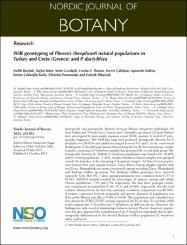| dc.contributor.author | Boydak, Melih | en_US |
| dc.contributor.author | Teker, Tuğba | en_US |
| dc.contributor.author | Gazdağlı, Aylin | en_US |
| dc.contributor.author | Thanos, Costas A. | en_US |
| dc.contributor.author | Çalışkan, Servet | en_US |
| dc.contributor.author | Kaltsis, Apostolis | en_US |
| dc.contributor.author | Çalikoğlu Tozlu, Emine | en_US |
| dc.contributor.author | Fournaraki, Christini | en_US |
| dc.contributor.author | Albayrak, Gülruh | en_US |
| dc.date.accessioned | 2021-11-09T16:54:52Z | |
| dc.date.available | 2021-11-09T16:54:52Z | |
| dc.date.issued | 2021-10 | |
| dc.identifier.citation | Boydak, M., Teker, T., Gazdağlı, A., Thanos, C. A., Çalışkan, S., Kaltsis, A., Çalikoğlu Tozlu, E., Fournaraki, C. & Albayrak, G. (2021). ISSR genotyping of Phoenix theophrasti natural populations in Turkey and Crete (Greece) and P. Dactylifera. Nordic Journal of Botany, 39(10), 1-11. doi:10.1111/njb.03104 | en_US |
| dc.identifier.issn | 0107-055X | |
| dc.identifier.issn | 1756-1051 | |
| dc.identifier.uri | https://hdl.handle.net/11729/3283 | |
| dc.identifier.uri | http://dx.doi.org/10.1111/njb.03104 | |
| dc.description | This work was supported by the Scientific Research Projects Coordination Unit of Isik University, Project No. 16A401. | en_US |
| dc.description.abstract | Intraspecific and interspecific diversity between Phoenix theophrasti individuals (92 from Turkey and 70 from Crete, Greece) and P. dactylifera specimens (28 from Turkey) were investigated by inter-simple sequence repeat (ISSR) analysis. A total of 45 polymorphic fragments, 360–3454 bps long, were produced. Intraspecific diversity for P. dactylifera was 26.63% and similarities ranged between 0.5 and 1. In the constructed dendrogram, P. dactylifera specimens clustered together in the first main group, outside branches consisting of P. theophrasti samples that generated the second main group. The intraspecific diversity for Turkish P. theophrasti populations was found to be 18.60% and for Cretan populations 13.45%. Antalya–Kumluca–Karaöz samples were grouped outside the branches of the remaining P. theophrasti samples. All three Cretan populations formed their own, separate branch. Datça–Eksera Stream samples together with two Datça–Hurmalıbük specimens constituted a group excluding Datça–Hurmalıbük and Bodrum–Gölköy specimens. Five Bodrum–Gölköy genotypes were clustered separately. Gene flow (Nm) values among populations were estimated from 0.157 to 59.615. AMOVA analysis revealed the percentages of variance among and within Phoenix populations: 73% and 27%, respectively. The first three principal coordinate components accounted for 37.60, 29.32 and 20.04%, respectively, thus the total variance obtained from the first three principal coordinate components was 86.96%. A positive correlation between geographic and genetic distances of populations was detected by Mantel tests (Rx,y = 0.44, p = 0.04). The populations were classified into four clusters by STRUCTURE analysis, supported the PCoA data. To conclude, ISSR results support that P. dactylifera and P. theophrasti are different species. Moreover, the findings not only revealed relationships between natural Phoenix theophrasti populations but also supported the identification of the P. theophrasti individuals that are phenotypically differentiated in the divided Bodrum–Gölköy population (P. theophrasti subsp. golkoyana). | en_US |
| dc.language.iso | eng | en_US |
| dc.publisher | John Wiley and Sons Inc | en_US |
| dc.relation.isversionof | 10.1111/njb.03104 | |
| dc.rights | info:eu-repo/semantics/closedAccess | en_US |
| dc.subject | Analysis of molecular variance (AMOVA) | en_US |
| dc.subject | Genetic diversity | en_US |
| dc.subject | Genetic variation | en_US |
| dc.subject | Germplasm | en_US |
| dc.subject | Inter-simple sequence repeat (ISSR) analysis | en_US |
| dc.subject | L. | en_US |
| dc.subject | Markers | en_US |
| dc.subject | Palms | en_US |
| dc.subject | Phoenix dactylifera | en_US |
| dc.subject | Phoenix theophrasti | en_US |
| dc.subject | Polymerase | en_US |
| dc.subject | Principal coordinate analysis (PCoA) | en_US |
| dc.subject | Software | en_US |
| dc.title | ISSR genotyping of Phoenix theophrasti natural populations in Turkey and Crete (Greece) and P. Dactylifera | en_US |
| dc.type | article | en_US |
| dc.description.version | Publisher's Version | en_US |
| dc.relation.journal | Nordic Journal of Botany | en_US |
| dc.contributor.department | Işık Üniversitesi, Güzel Sanatlar Fakültesi, Peyzaj Mimarlığı Bölümü | en_US |
| dc.contributor.department | Işık University, Faculty of Fine Arts, Department of Landscape Architecture | en_US |
| dc.contributor.authorID | 0000-0001-6287-5038 | |
| dc.identifier.volume | 39 | |
| dc.identifier.issue | 10 | |
| dc.identifier.startpage | 1 | |
| dc.identifier.endpage | 11 | |
| dc.peerreviewed | Yes | en_US |
| dc.publicationstatus | Published | en_US |
| dc.relation.publicationcategory | Makale - Uluslararası Hakemli Dergi - Kurum Öğretim Elemanı | en_US |
| dc.contributor.institutionauthor | Boydak, Melih | en_US |
| dc.relation.index | WOS | en_US |
| dc.relation.index | Scopus | en_US |
| dc.relation.index | Science Citation Index Expanded (SCI-EXPANDED) | en_US |
| dc.description.quality | Q4 | |
| dc.description.wosid | WOS:000702312000001 | |



















